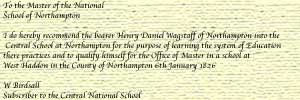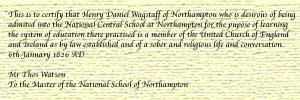During the early part of the 1800s only about a fifth of all children in England and Wales were attending school, with most children having no access to education of any sort. As Britain became more industrialised the need for an educated, skilled population grew and hence during the 19th century education developed and grew steadily.
Elementary education was mainly provided by two voluntary societies:
1) The “National Society for the Education of the poor, in accordance with the Principles of the Established Church” was founded in 1811. It was an Anglican organisation and demanded that only children who were regular church goers could attend the National School.
2) The British and Foreign Schools Society. The latter was founded in 1814 based on the principles of Thomas Lancaster, a Quaker. Although Bible reading was undertaken, religious teaching in the British and Foreign Schools was non-sectarian.
The first recorded school masters to take up their positions in 1825 were Mr Daniel Wagstaff and Mr Benjamin Collis.
The school was attended by children aged between 5 and 12 years and were taught reading, writing, to cast accounts (Lancastrian Plan or Bells system), English grammar. In addition, girls were also instructed in knitting and plain needlework.
A review of the Education Returns for 1833 noted that the attendance roll for the Heygate School consisted of 70 males and 21 females.
The Master and Mistress were paid £45 per annum
 |

 |
The Established Church Sunday School
-supported by subscription
-teachers salary £10 per annum
-ROLL 58 boys and 27 girls
The Baptist Sunday School
-(Chapel erected in 1820)
-supported by congregational collections
-teachers unpaid
-ROLL 26 boys and 36 girls
The Wesleyan Methodist Sunday School
-(Chapel erected in 1811; demolished around 1920)
-supported by congregational collections
-teachers unpaid
-ROLL 24 boys and 26 girls